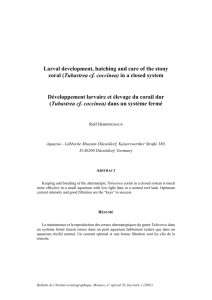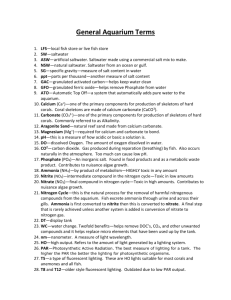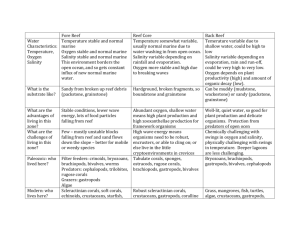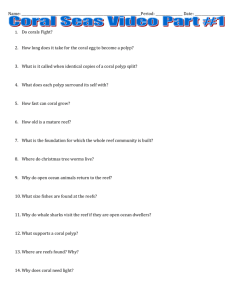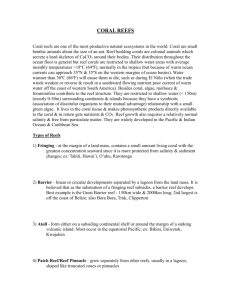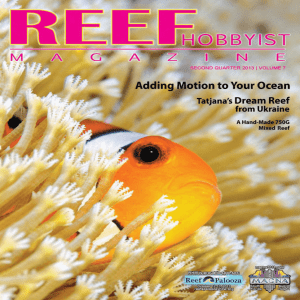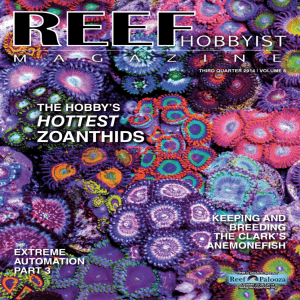The panoramic reef aquarium of the Aquazoo Düsseldorf
advertisement
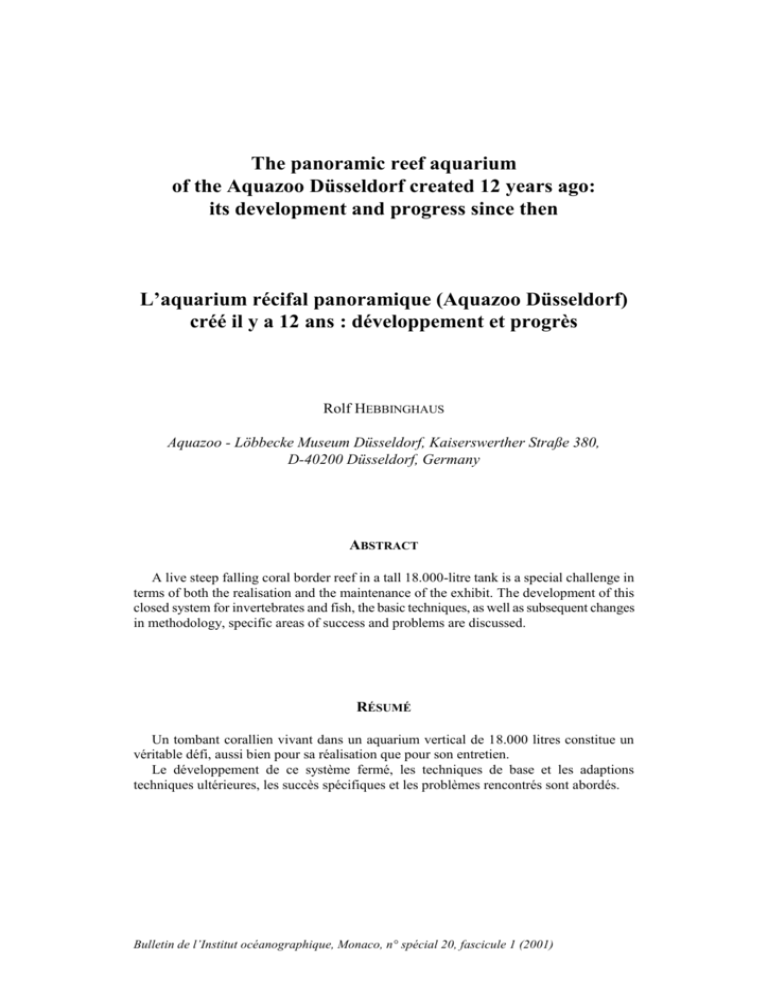
The panoramic reef aquarium of the Aquazoo Düsseldorf created 12 years ago: its development and progress since then L’aquarium récifal panoramique (Aquazoo Düsseldorf) créé il y a 12 ans : développement et progrès Rolf HEBBINGHAUS Aquazoo - Löbbecke Museum Düsseldorf, Kaiserswerther Straße 380, D-40200 Düsseldorf, Germany ABSTRACT A live steep falling coral border reef in a tall 18.000-litre tank is a special challenge in terms of both the realisation and the maintenance of the exhibit. The development of this closed system for invertebrates and fish, the basic techniques, as well as subsequent changes in methodology, specific areas of success and problems are discussed. RÉSUMÉ Un tombant corallien vivant dans un aquarium vertical de 18.000 litres constitue un véritable défi, aussi bien pour sa réalisation que pour son entretien. Le développement de ce système fermé, les techniques de base et les adaptions techniques ultérieures, les succès spécifiques et les problèmes rencontrés sont abordés. Bulletin de l’Institut océanographique, Monaco, n° spécial 20, fascicule 1 (2001) Seen from outside; our Institute’s former building is anything but a jewel; despite very poor working conditions the “shelter aquarium” in Brehmstraße already displayed an interesting variety of freshwater and seawater organisms. In 1987 the Institute moved to the Nordpark into a nice big new building, the life’s work of the former director, Prof. Dr. Manfred Zahn, who retired in March 1994. The Aquazoo-Löbbecke Museum now offers visitors a fascinating and didactically excellent educational and recreational facility, and very good working conditions for the staff. Of course, the shelter had no live coral reef in the semicircular, 15-metre long aquarium that was structured to resemble the drop-off zone of a reef. In the years following the opening of the new building in July 1987, the panoramic reef aquarium (which is a closed system!) was developed to become the highlight of our seawater section. But this did not go without problems. In 1989, when I was hired, the tank decoration, made partly of limestone and partly of plastic material, was already plentifully colonised. Unfortunately there was not much coral, instead it was covered with thousands of glass roses (Aiptasia sp.) and a wide variety of algae. What had happened? I believe my colleagues simply had too much sympathy: they fed, or more precisely, they tried to feed the symbiotic corals intensively. This is what kills every reef aquarium! Because large-scale water changes are not recommended, the only way of turning the situation around was by reducing the food dramatically. The fish were now fed more often with high-quality flake food, which results in much less phosphate being released during feeding than with frozen food. All supplemental feeding of corals and other invertebrates was completely stopped. Within one year, the phosphate concentration was reduced to less than 0.02 mg per litre, and the nitrate concentration fell below 1 mg per litre. These fantastic values could be maintained for many years. In addition, an active carbon filter was installed with a constant but very low flow rate. The active carbon filter eliminates the harmful so-called “Gelbstoffe” (‘yellow stuff’). The algae and glass roses disappeared, the latter also thanks to the assistance of two Chelmon rostratus. In the free areas, we settled fast-growing soft corals. Later, we added more and more hard corals and, in 1996, the aquarium had achieved a wonderful rapid coral growth (approximately 35 species of hard and 20 species of soft corals) - but further improvements were still needed (1). In the beginning, the corals developed only in the right third of the tank. The reason was the strong current in this area because this was the outlet for the only pump we had at that time. This pump is connected to our trickle-bed filter, which is about 3 metres high. Although the pump is very powerful and pumps 50,000 litres per hour, the current was not strong enough for the long stretch of the 18,000-litre reef tank. In the middle of the tank the current was very weak, of course this is also due to the curve in the tank. Whilst in the right third of the tank big colonies of Pocillopora sp. and Montipora sp. were already growing, mainly secondary Bulletin de l’Institut océanographique, Monaco, n° spécial 20, fascicule 1 (2001) colonisers instead of hard corals, grew at the same time in the left third. The solution for this problem was a ring pipe at the back of the tank. The water is fed in the pipe with two strong high-pressure pumps. The ring pipe has outlets every 40 cm. The diameter of the outlet tubes is 16 mm and each of them can be controlled separately. Almost invisible to visitors, the current is directed from the back to the front of the tank, where the water is moving down, coming back over the ground to the back and moving upwards along the decoration. The result of this construction is that current is produced almost everywhere in our circular drop-off reef. This was a major point for coral growth (2). We attached filter cartridges (made in-house) to the two pressure pumps. The water is drawn up all around the filter surface and we cleaned them twice a week. Because the volume of these cartridges is relatively small, they can intercept even the finest particles. After an adaptation period of only a few hours they produce crystal-clear water. Some of the “Gelbstoffe” is also eliminated. In summary these filters significantly reduce the organic load. In the first years the lighting consisted of twelve 400-Watt HQI daylight projectors. Later we had to increase the lighting, by adding another six 400-Watt HQI projectors and two 1000-Watt HQIs. Nevertheless there remained a dark spot: Because the tank is 1.4 m in height and just 60 cm wide in some areas, there is a problem in providing enough light to the corals on the ground without damaging those growing near the surface. Today some of the uppermost corals almost touch the front glass. For visitors this presents a fantastic possibility for observation while the keeper can demonstrate his ‘artistic talent’ ...for example when coral has to be moved. His main tools are a glass-bottom box, the mirror image in the front glass of the tank and a single plastic claw arm. I cannot tell you how we would survive without this claw arm (3 - left + 4 - right)! Due to the increasing coral growth the carbonate hardness decreased from 8 degrees to 4 degrees (German hardness) at the end of 1991. As a result, the growth of hard corals almost stopped. First we tried to increase the carbonate hardness by changing more water and adding more calcium hydroxide-water, but that was in vain. We invented the “Löbbecke calcium carbonate reactor” and were able to increase the carbonate hardness to 13 degrees within a few months. Now, the largepolyp scleractinians were growing 50% faster and the small-polyp scleractinians and soft corals were growing up to 100% faster compared to the previous period, when carbonate hardness was at 8 degrees. So far this apparatus has been working almost without change, although the pump was replaced by a new type and a second container was installed behind it to use the residual carbon dioxide. After installing the reactor, the aquarium has been running to our complete satisfaction for three years. Bulletin de l’Institut océanographique, Monaco, n° spécial 20, fascicule 1 (2001) The hard corals (Oulophyllia crispa, Pocillopora damicornis and Heliofungia actiniformis) were even multiplying by themselves, the latter via larvae and the first two via polyp bailout. Although relatively poorly lit, large areas of the ground were covered with dense fast pulsating Xenia umbellata colonies. I would like to point out that the aquarium did not yet have a skimmer at that time! And so far, the only trace elements we have added are iodine and strontium. In the Acropora sp. colonies we sometimes had to deal with the problem of some coral branches shading others from light and current. The result was a mass attack by the ciliate Helicostoma nonatum, a parasite that is also always detectable in small numbers on healthy corals. However, we were always able to stop this disease quickly by cutting off the infected branches or by drawing up the ciliates. In 1994 we started step by step to connect most of the other tropical aquariums into the same water circuit as the reef tank. This led to increasing the water volume to about 25,000 litres. The smaller tanks, with greater organic loads, benefited from this connection. Over the years, the phosphate and nitrate concentrations remained constant despite the increased organic load. Then the phosphate value rose slowly to about 0.2 mg per litre (ten times more than before). We installed a powerful skimmer (Sander Helgoland), but the phosphate value remained unchanged at 0.2 mg/l. In parallel with the increase in phosphate we were faced with three serious plagues. First, a feathered green algae Bryopsis killed many Acropora sp. colonies by suffocation. We did not find any fish that feed on these algae. The sea urchin (Tripneustes gratilla) does eats these algae to some extent but, sooner or later, it ends up falling victim to our sea anemones. The second plague was the small sea anemone (Anemonia cf. manjano) and the third plague was a green zoanthid, probably Zoanthus sociatus; both have an unbelievable growth rate and they are very difficult to remove. In the meantime they have covered several square meters in our reef tank. Up to now we have not found suitable predators. Be happy if you don't have these two cnidaria in your reef tank, and if you do, don’t hesitate to remove them! Finally, a few words on the fishes in our reef tank. The darling of the visitors is our 18-year-old Naso unicornis. The Naso and our surgeonfishes are given salad or other green food three times a week, so we never had problems with the notorious ‘hole disease’. Anthias are much easier to keep than the literature would lead us to believe. The only difficulty is that they need finely minced food at least three times a day. Once adapted, they even feed on flake food, if it is of good quality and not too ‘old’. Our Chromis viridis are spawning every day on the Acropora branches. Pterapogon kauderni are spawning, too, and some of the young survive even in this tank (5). Bulletin de l’Institut océanographique, Monaco, n° spécial 20, fascicule 1 (2001) Two pairs of Gobiodon okinawae find hiding places in the big Acropora sp. corals. They feed on the tentacle tips and always spawn on the same branch. Their affect on the corals is minimal. Even Oxymonacanthus longirostris have been doing well in this reef tank for three years; although they never take part in feeding, they are well fed. In the literature it is said that this fish feeds on the polyps of Acropora sp., but its mouth is too big for this food! In truth it just plucks off the tentacles of the polyps. For the corals this makes a very big difference. A plucked off tentacle can regenerate within a few days, but if a whole polyp is torn away, it would be easy for foreign organism to settle on the naked skeleton. Slide captions: 1. The panoramic reef aquarium (4m section) in 1996 (W. Hochstetter) 2. The ring pipe at the back of the tank and the lighting (Hebbinghaus) 3. Difficult work with the claw arm and the glass-bottom box (Hebbinghaus) 4. View through the water surface over splendid Acropora corals (Hebbinghaus) 5. Both successfully multiplying in the 18.000 litre reef tank: P. kauderni and Heliofungia actiniformis (Hebbinghaus) Bulletin de l’Institut océanographique, Monaco, n° spécial 20, fascicule 1 (2001) Bulletin de l’Institut océanographique, Monaco, n° spécial 20, fascicule 1 (2001)

